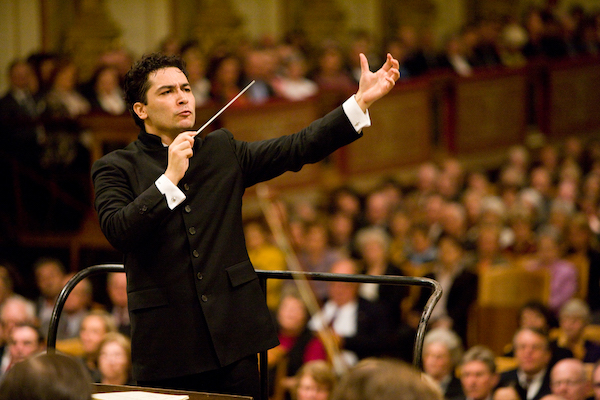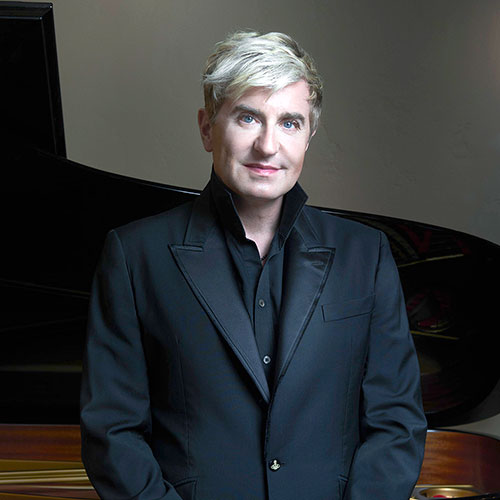A switch is the only hitch in Houston Symphony’s brilliant evening of showpieces

Without clueing in the audience to the switch, the Houston Symphony reversed the halves of Friday’s concert at Jones Hall — in other words, conductor Andrés Orozco-Estrada and the orchestra began with the works listed in the program as following intermission.
Since piano soloist Jean-Yves Thibaudet didn’t walk onstage until the concert’s finale, the audience no doubt figured out the swap between George Gershwin’s Concerto in F, which was supposed to end the first half, and the Catfish Row suite from Gershwin’s Porgy and Bess, which actually did.
But when it came to the shorter pieces that began each half, chances are that some concertgoers remained in a haze as to which was Aaron Copland’s El Salón México and which was Carlos Chávez’s Sinfonía india. After all, both are one-movement works lasting 10 to 12 minutes, and both spring from Mexican folk music.
Let the record show that Copland opened the concert, despite what the program indicated. In any case, the orchestra brought out the spirit and electricity of both El Salón México, inspired by Copland’s visit to a Mexico City nightclub of that name, and Sinfonía india, based on music of Mexico’s ancient peoples. (Besides sharing Mexican roots, the works have another link: Chávez, who conducted as a sideline, led El Salón México’s premiere in 1937.)
After flinging out El Salón México’s opening fanfares, Orozco-Estrada and the orchestra treated the lyrical first scene to a coziness it rarely enjoys. The orchestra’s sound was gentle and sweet. Orozco-Estrada led the players to spin out melodies smoothly, and at times he gave soloists leeway to savor juicy turns of phrase at their own pace.
When the dance hall’s excitement welled up, the orchestra dug into the lusty tunes, filling the music with bold rhythms and vivid colors. Amid the bustle, the outcries of the E-flat clarinet — higher-pitched than the basic clarinet — exuded high spirits through their freewheeling slides, with a sound just this side of a squeal. When everything boiled down to broad, rugged phrases punctuated by booms from the percussion, the orchestra’s meaty tone made them grand and resounding rather than clunky, as they are with some orchestras.
Sinfonía india, too, offered more than vitality. The orchestra made the opening crisp and bright, but for all the chattering action, Orozco-Estrada and the players saw that a tune always sailed out clearly. When the pace slowed, the clarinet gave its melody a lilt that set a new scene, and the strings amplified the tune’s charm when they sang it out.
The French horns established yet another mood when they intoned their quiet but stately theme, and Orozco-Estrada spurred the orchestra to build it to a resounding climax. Then the group sprung into action with a new salvo of incisive themes, propelling the Sinfonía to a walloping finish.
In Gershwin’s Catfish Row, the orchestra bridged the passion of Porgy and Bess’ characters and the grandeur of its operatic scale. Vivid solos complemented the full ensemble’s color and luxury.
Scott Holshouser tossed off the introduction’s barroom-piano solo with a gusto that established the Charleston setting’s earthiness. Concertmaster Yoonshin Song spun out the first stanza of “Summertime” with gleaming purity, then oboist Jonathan Fischer gave the second verse his own graceful turns. Trombonist Allen Barnhill stepped out crisply in Porgy’s “I Got Plenty o’ Nuttin’.”
The strings then took over with the tune of Porgy’s “Bess, You Is My Woman Now,” and their glow captured the fervor of his love. Orozco-Estrada amplified that through the sheer shapeliness of the melody–guiding the violins to linger over the last, highest part of the ascent to the start of another stanza.
The orchestra’s dynamism delivered the electricity of the fugue that accompanies Porgy’s fight with the opera’s bad guy; the group’s delicacy and sheen put across the serenity of the music describing morning in Catfish Row. And Porgy’s “Oh Lawd, I’m on My Way” capped of the suite in style, growing from pulsing exuberance to a gleaming big finish.
New York is where Porgy is headed at the opera’s close, and Gershwin’s Concerto in F has an air of big-city excitement and glamor.
Orozco-Estrada led the orchestra to savor the concerto’s breeziness, vitality and suave lyricism. In the first and last movements, the orchestra’s playing ranged from buoyant to sleek to explosive. Mark Hughes’ mellow, unhurried trumpet solo launched the slow movement with an entirely different mood, pensive and still, and the rest of the orchestra picked up on the muted, nighttime mood. But before the movement was done, Orozco-Estrada guided the group to well up sleekly in another big Gershwin tune.

At center stage, pianist Thibaudet added his own pizazz. Right from the start, he displayed a poetic, unfettered spirit: In Thibaudet’s hands, the meditative opening solo could change in a flash from restless to introspective and back again.
Thibaudet brought that mercurial flavor to the whole concerto. In the first movement, his playing embraced dash and sleekness as well as rumbling power. Entering amid the second movement’s pensiveness, Thibaudet’s deft touch helped the jaunty piano theme turn the music in a new direction.
In the finale, his fleetness and bite yielded a new level of brash excitement. Then Thibaudet balanced out the fireworks through the serenity, limpidness and simple eloquence he gave his encore, Maurice Ravel’s Pavane pour une infante défunte.
The Houston Symphony repeats the program at 8 p.m. Saturday and 2:30 p.m. Sunday at Jones Hall. houstonsymphony.org; 713-224-7575.